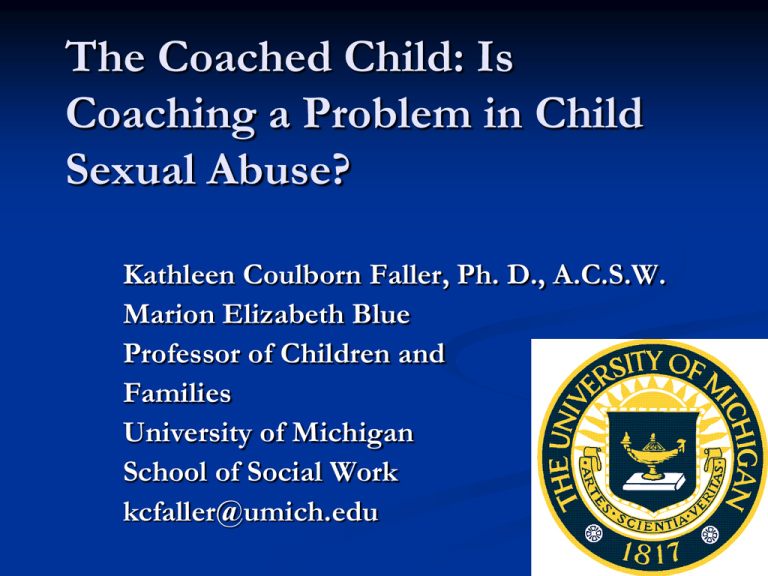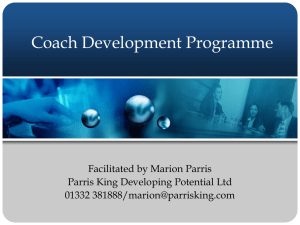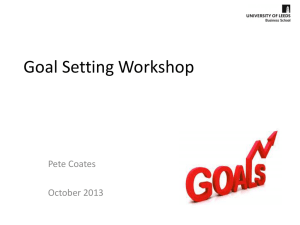
The Coached Child: Is
Coaching a Problem in Child
Sexual Abuse?
Kathleen Coulborn Faller, Ph. D., A.C.S.W.
Marion Elizabeth Blue
Professor of Children and
Families
University of Michigan
School of Social Work
kcfaller@umich.edu
Topics for the Session
Coaching survey
Coaching children about sexual abuse: A pilot
study of professionals’ perceptions
Video case example
Studies that indirectly address the issue of
coaching
Real world studies
Analogue studies
Incidence studies
Studies that specifically try to coach and program children
Practice suggestions
Coaching Survey
Please complete the coaching survey.
Faller, K.C. (2007). Coaching children about
child abuse: Professionals’ perceptions of the
problem. Child Abuse & Neglect: The
International Journal. 31(9), 947-959.
192 professionals—attendees at 6 conferences
Male=48
Female=136
No gender=8
Mean age=39.7
Range=24-79
Mean number of years working with
children=10.5 Range=0-35
Education
Bachelors=66
Masters=85
PhD/MD/JD=27
Demographic Differences
Women more likely to have Masters Degree
as their highest degree than men.
Men more likely to have PhD/MD/JD as
highest degree than women.
Women had on average 11 years of
experience.
Men had on average 9 years of experience.
Coaching
I have worked on a case involving a coached
child
Yes=
No=
Unsure=
153 (79.7%)
14 (7.3%)
22 (11.5%)
Number of cases
Mean=
Median=
Mode=
12.3 (SD=52)
3
2
15
10
Frequency
Number seen
Number of Coached
Cases Seen
25
20
5
0
00
0.
60 00
0.
10
0
.0
50
0
.0
40
0
.0
30
0
.0
25
0
.0
20 0
.0
15
0
.0
12
0
.0
10
00
8.
00
7.
00
6.
00
5.
00
4.
00
3.
00
2.
00
1.
0
.0
Number seen
Major Findings
Who coaches?
First rank
Mothers=
Fathers=
Other relatives=
151
15
18
78.6%
7.8%
4.2%
17
119
15
8.9%
62.0%
7.8%
Second rank
Mothers=
Fathers=
Other relatives=
Major Findings
What kinds of cases?
First rank
Divorce/custody=
Physical abuse=
145
13
75.5%
6.8%
15
64
7.8
33.3%
Second rank
Divorce/custody=
Physical abuse=
What interventions are best when
there is coaching?
Number
Therapy
134
Confrontation
by professional
79
Confrontation
by accused
15
Supervised visits 66
Unsupervised visits 5
Change of custody 11
Percent
69.8%
41.1%
7.8%
34.4%
2.6
5.7
Gender differences
There were no significant differences by gender in whether the
professional had worked on a case involving a coached child,
the number of such cases, or who did the coaching.
However, there were differences by gender in intervention
strategies endorsed.
Women professionals (N=106, 78%) were more likely to use
therapy than men (N=26, 54%) [Chi sq. (2, N=184)=10,
p=.007].
Men (N=28, 58%) were more likely to confront the child than
women (N=49, 26%) [Chi sq. (2, N=184)=7.3, p=.02].
Men (N=7,15%) were more likely than women (N=4, 3%) to
endorse a change of custody to the accused than women,
when they thought the child had been coached [Chi sq (2,
N=184)=8.7, p=.01].
Additional Research Relevant to
the Issue of Coaching
Research cannot tell you whether a child has
been coached in a specific case, but it can
inform you about the frequency, contexts, and
characteristics of coaching situations.
Real world studies: studies of actual cases.
Analogue studies: research that involves either
staged or naturally occurring events in children’s
lives.
Frequency of coaching
Oates, Jones, Denson, Sirotnak, Gary, &
Krugman, Erroneous concerns about
child sexual abuse. Child Abuse &
Neglect, 2000.
•
•
•
Reports of sexual abuse to child protective
services
N=551
14 (2.5%) erroneous concerns from children
3 (1/2%) made in collusion with parents (may have
been coached).
3 (1/2%) misinterpretations.
8 (1.5%) false by children (may have been coached).
Trocme & Bala, False allegations of
abuse and neglect when parents
separate. Child Abuse & Neglect, 2005
1998 Canadian Incidence Study data (N=7,672).
Collected from Child Protection staff—their
perceptions of deliberate false allegations.
Studied all types of intentionally false allegations of
abuse.
Overall percentage of intentional false allegations
was 4%.
Neglect was the most common false allegation, but
the percent for sexual abuse cases was greater 6%.
In custody cases 12% were considered false.
Trocme & Bala, contd.
Non-custodial parents—mostly fathers
(15%) and anonymous reporters (25%) were
the most common reporters of intentional
false allegations.
The rate for custodial parents—mostly
mothers, was 2%.
The rate of false reports by children was 4%.
There were no instances of false allegations of
sexual abuse by children.
Only 2 intentional false allegations were
against non-custodial parents.
Analogue Studies
Called analogue studies because the events are
supposed to be analogous with abuse and the
questioning techniques analogous with forensic
interviewing.
Most are with non-abused kids who live around
universities.
Vary in their ecological validity.
Vary in whether they are balanced to show
children’s strengths and weaknesses or primarily
focused on showing their weaknesses.
False negatives are high in many
analogue studies
Saywitz, K., Goodman, G., Nicholas, E. & Moan.
(1991). Children's memory for a genital examination.
Journal of Consulting and Clinical Psychology.
Steward, M. S., Steward, D. S., Farquhar, L., Myers, J.,
Welker, J., Joye, N., Driskill, J., & Morgan, J. (1996).
Interviewing young children about body touch and
handling. SRCD.
Goodman, G., Quas, J., Batterman-Faunce, J.,
Riddelsberger, M., & Kuhn, J. (1997). Children's
reaction to and memory of a stressful event. Applied
Developmental Science.
But there is also evidence from
analogue studies that children can be
coached
Clarke-Stewart, A., Thompson, W., & Lapore, S. (1989,
April). Manipulating children's interpretations through
interrogation. SRCD.
Ceci, S., Huffman, M., Smith, E., & Loftus, E. (1994).
Repeatedly thinking about a non-event. Consciousness and
Cognition.
Bruck, M., Ceci, S. J., & Hembrooke, H. (2002). The nature
of children’s true and false narratives. Developmental
Review, 22, 520–554.
Leichtman, M., & Ceci, S. (1995). Sam Stone.
Developmental Psychology.
Illustrative Analogue Study
Saykaly, Talwar, Lindsay, Bala, & Lee. (2013).
The Influence of Multiple Interviews on the
Verbal Markers of Children’s Deception. Law &
Human Behavior, 37 (3), 187–196.
This study examined what are thought to be
characteristics of true and coached (false)
reports.
This is a recent study that illustrates the kind of
research undertake to demonstrate that children
can be coached.
78 4-11 year old non-abused children; M=7.58
Separately each child visited a Research
Assistant and played 1 of 3 games for 15
minutes.
Visited with the research assistant 3 times, with
the same protocol.
Games: 1. doctor game (ID body parts); 2.
guessing game (guess ID of an object on a card);
3. memory game (locate pairs of cards)
After each correct response, the Research
Assistant placed a sticker on the child’s arm,
hand, knee, or cheek.
Parents were told to instruct their child to tell a
second Research Assistant about the real game
they had played but also to instruct the child to
falsely state they had played a second game.
Parents were told to drill their child on the false
game for 15 minutes before each of three visits
by Research Assistant 2.
Researchers questioned the parents to make sure
they had followed instructions.
Research on the Interviews by
Research Assistant 2
The child interviews were audi recorded and
transcribed for analysis
Variables the researchers coded are ones
thought to indicate a true account
Cognitive operations—e.g., I know, remember
Self reference—use of I, we, us.
Spontaneous corrections
Temporal markers—contextualizing the event in
time
More factors
Lack of knowledge—e.g., I don’t remember
Sensori-motor information—e.g., what things
tasted like, smelled like, felt like
Spatial information—where things were in the
room
Affective terms—love, desire
Reproduction of dialogue
Unusual details—idiosyncratic event
Findings
In the children’s first interview, the true
allegations had more spontaneous corrections
and fewer temporal references.
False reports had more admissions of lack of
knowledge during the first interview.
Over the two subsequent interviews, which were
preceded by additional parental coaching
sessions, differences between true and coached
reports largely disappeared.
Conclusions from the Research
False allegations of sexual abuse by children are
uncommon.
Most false reports are misinterpretations.
Most false allegations are made by adults.
When they are made, they are not usually made by
mothers, but rather by non-custodial caretakers or
anonymous reporters.
Coaching of children to make a false allegation
is very uncommon, but it can be done.
The more a child is coached, the more the allegation
sounds like a true one.
Strategies for addressing coaching
Related to the interview.
Have the child brought by a neutral party.
Have the adult tell the child to tell the truth.
Interview the child without an adult present.
Rules—Only tell me what really happened.
Ask the child to promise to tell the truth.
Gently challenge—Is that something that really happened or is
that pretend?
Query—Is this something that you remember or is this
something people talked to you about or told you about? Is that
something they talk about in your family?
Use of media—e.g. draw me a picture of what happened; show
me.
Probe for details and affect.
Strategies for addressing coaching
External to the interview.
Admonish adults not to talk to the child about
the allegations.
Put the child in treatment.
Ask the adults to go to treatment.
Use mediation with the parents.
Special investigation techniques
for multi-victim cases
More directly address contamination.
QUESTIONS?







